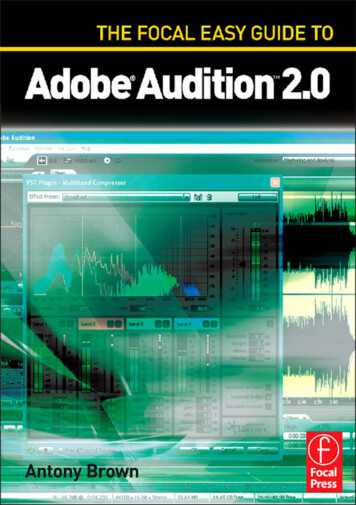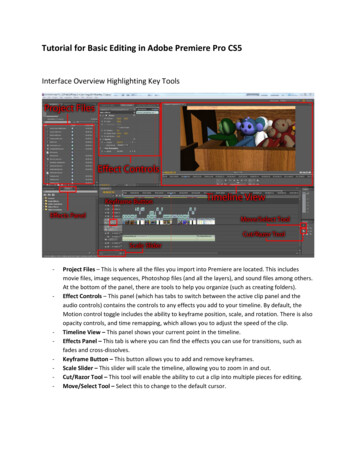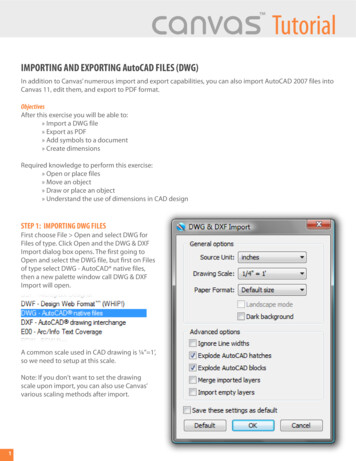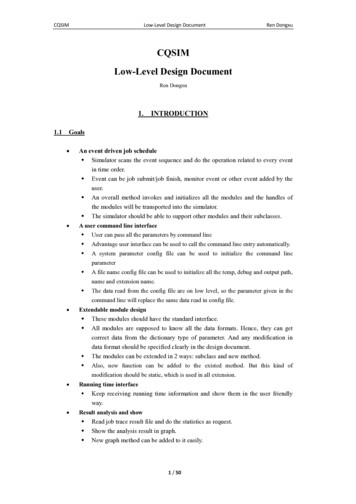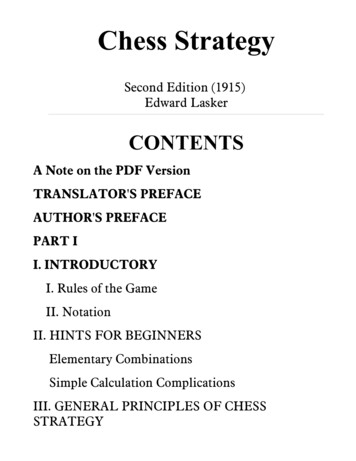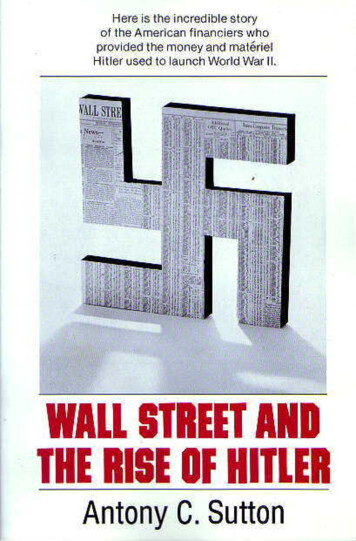
Transcription
PREFACEThis is the third and final volume of a trilogy describing the role of the American corporatesocialists, otherwise known as the Wall Street financial elite or the Eastern LiberalEstablishment, in three significant twentieth-century historical events: the 1917 LeninTrotsky Revolution in Russia, the 1933 election of Franklin D. Roosevelt in the UnitedStates, and the 1933 seizure of power by Adolf Hitler in Germany.Each of these events introduced some variant of socialism into a major country — i.e.,Bolshevik socialism in Russia, New Deal socialism in the United States, and Nationalsocialism in Germany.Contemporary academic histories, with perhaps the sole exception of Carroll Quigley'sTragedy And Hope, ignore this evidence. On the other hand, it is understandable thatuniversities and research organizations, dependent on financial aid from foundations that arecontrolled by this same New York financial elite, would hardly want to support and topublish research on these aspects of international politics. The bravest of trustees is unlikelyto bite the hand that feeds his organization.It is also eminently clear from the evidence in this trilogy that "public-spirited businessmen"do not journey to Washington as lobbyists and administrators in order to serve the UnitedStates. They are in Washington to serve their own profit-maximizing interests. Theirpurpose is not to further a competitive, free-market economy, but to manipulate apoliticized regime, call it what you will, to their own advantage.It is business manipulation of Hitler's accession to power in March 1933 that is the topic ofWall Street and the Rise of Hitler.ANTONY C. SUTTONJuly, 1976BACK
WALL STREET ANDTHE RISE OF HITLERByAntony C. SuttonTABLE OF CONTENTSPrefaceIntroductionUnexplored Facets of NaziismPART ONE: Wall Street Builds Nazi IndustryChapter OneWall Street Paves the Way for Hitler1924: The Dawes Plan1928: The Young PlanB.I.S. — The Apex of ControlBuilding the German CartelsChapter TwoThe Empire of I.G. FarbenThe Economic Power of I.G. FarbenPolishing I.G. Farben's ImageThe American I.G. FarbenChapter ThreeGeneral Electric Funds HitlerGeneral Electric in Weimar, GermanyGeneral Electric & the Financing of Hitler
Technical Cooperation with KruppA.E.G. Avoids the Bombs in World War IIChapter FourStandard Oil Duels World War IIEthyl Lead for the WehrmachtStandard Oil and Synthetic RubberThe Deutsche-Amerikanische Petroleum A.G.Chapter FiveI.T.T. Works Both Sides of the WarBaron Kurt von Schröder and I.T.T.Westrick, Texaco, and I.T.T.I.T.T. in Wartime GermanyPART TWO: Wall Street and Funds for HitlerChapter SixHenry Ford and the NazisHenry Ford: Hitler's First Foreign BankerHenry Ford Receives a Nazi MedalFord Assists the German War EffortChapter SevenWho Financed Adolf Hitler?Some Early Hitler BackersFritz Thyssen and W.A. Harriman CompanyFinancing Hitler in the March 1933 ElectionsThe 1933 Political ContributionsChapter EightPutzi: Friend of Hitler and RooseveltPutzi's Role in the Reichstag FireRoosevelt's New Deal and Hitler's New OrderChapter Nine
Wall Street and the Nazi Inner CircleThe S.S. Circle of FriendsI.G. Farben and the Keppler CircleWall Street and the S.S. CircleChapter TenThe Myth of "Sidney Warburg"Who Was "Sidney Warburg"?Synopsis of the Suppressed "Warburg" BookJames Paul Warbur's AffidavitSome Conclusions from the "Warburg" StoryChapter ElevenWall Street-Nazi Collaboration in World War IIAmerican I.G. in World War IIWere American Industrialists and FinanciersGuilty of War Crimes?Chapter TwelveConclusionsThe Pervasive Influence of International BankersIs the United States Ruled by a Dictatorial Elite?The New York Elite as a Subversive ForceThe Slowly Emerging Revisionist TruthAppendix AProgram of the National Socialist GermanWorkers PartyAppendix BAffidavit of Hjalmar SchachtAppendix CEntries in the "National Trusteeship" AccountAppendix D
Letter from the U.S. War Department toEthyl CorporationAppendix EExtract from Morgenthau Diary (Germany)FootnotesBibliographyIndex*****Dedicated to the memory of Floyd Paxton —entrepreneur, inventor, writer, and American, whobelieved in and worked for individual rights in afree society under the Constitution*****Copyright 2000This work was created with the permission of AntonyC. Sutton.All rights reserved. No portion of this book may bereproduced without written permission from theauthor, except by a reviewer who may quote briefpassages in connection with a review.HTML version created in the United States ofAmerica by Studies in Reformed Theology
CHAPTER ONEWall Street Paves the Way for HitlerThe Dawes Plan, adopted in August 1924, fitted perfectly into the plans of theGerman General Staffs military economists. (Testimony before United StatesSenate, Committee on Military Affairs, 1946.)The post-World War II Kilgore Committee of the United States Senate heard detailedevidence from government officials to the effect that,.when the Nazis came to power in 1933, they found that long strides had beenmade since 1918 in preparing Germany for war from an economic andindustrial point of view.1This build-up for European war both before and after 1933 was in great part due to WallStreet financial assistance in the 1920s to create the German cartel system, and to technicalassistance from well-known American firms which will be identified later, to build theGerman Wehrmacht. Whereas this financial and technical assistance is referred to as"accidental" or due to the "short-sightedness" of American businessmen, the evidencepresented below strongly suggests some degree of premeditation on the part of theseAmerican financiers. Similar and unacceptable pleas of "accident" were made on behalf ofAmerican financiers and industrialists in the parallel example of building the military powerof the Soviet Union from 1917 onwards. Yet these American capitalists were willing tofinance and subsidize the Soviet Union while the Vietnam war was underway, knowing thatthe Soviets were supplying the other side.The contribution made by American capitalism to German war preparations before 1940can only be described as phenomenal. It was certainly crucial to German militarycapabilities. For instance, in 1934 Germany produced domestically only 300,000 tons ofnatural petroleum products and less than 800,000 tons of synthetic gasoline; the balancewas imported. Yet, ten years later in World War II, after transfer of the Standard Oil of NewJersey hydrogenation patents and technology to I. G. Farben (used to produce syntheticgasoline from coal), Germany produced about 6 1/2 million tons of oil — of which 85percent (5 1/2 million tons) was synthetic oil using the Standard Oil hydrogenation process.Moreover, the control of synthetic oil output in Germany was held by the I. G. Farbensubsidiary, Braunkohle-Benzin A. G., and this Farben cartel itself was created in 1926 withWall Street financial assistance.On the other hand, the general impression left with the reader by modern historians is thatthis American technical assistance was accidental and that American industrialists wereinnocent of wrongdoing. For example, the Kilgore Committee stated:The United States accidentally played an important role in the technicalarming of Germany. Although the German military planners had ordered andpersuaded manufacturing corporations to install modern equipment for mass
production, neither the military economists nor the corporations seem to haverealized to the full extent what that meant. Their eyes were opened when two ofthe chief American automobile companies built plants in Germany in order tosell in the European market, without the handicap of ocean freight charges andhigh German tariffs. Germans were brought to Detroit to learn the techniquesof specialized production of components, and of straight-line assembly. Whatthey saw caused further reorganization and refitting of other key German warplants. The techniques learned in Detroit were eventually used to construct thedive-bombing Stukas . At a later period I. G. Farben representatives in thiscountry enabled a stream of German engineers to visit not only plane plantsbut others of military importance, in which they learned a great deal that waseventually used against the United States.2Following these observations, which emphasize the "accidental" nature of the assistance, ithas been concluded by such academic writers as Gabriel Kolko, who is not usually asupporter of big business, that:It is almost superfluous to point out that the motives of the American firmsbound to contracts with German concerns Were not pro. Nazi, whatever elsethey may have been.3Yet, Kolko to the contrary, analyses of the contemporary American business press confirmthat business journals and newspapers were fully aware of the Nazi threat and its nature,while warning their business readers of German war preparations. And even Kolko admitsthat:The business press [in the United States] was aware, from 1935 on, thatGerman prosperity was based on war preparations. More important, it wasconscious of the fact that German industry was under the control of the Nazisand was being directed to serve Germany's rearmament, and the firmmentioned most frequently in this context was the giant chemical empire, I. G.Farben.4Further, the evidence presented below suggests that not only was an influential sector ofAmerican business aware of the nature of Naziism, but for its own purposes aided Naziismwherever possible (and profitable) —with full knowledge that the probable outcome wouldbe war involving Europe and the United States. As we shall see, the pleas of innocence donot accord with the facts.1924: The Dawes PlanThe Treaty of Versailles after World War I imposed a heavy reparations burden on defeatedGermany. This financial burden — a real cause of the German discontent that led toacceptance of Hitlerism — was utilized by the international bankers for their own benefit.The opportunity to float profitable loans for German cartels in the United States waspresented by the Dawes Plan and later the Young Plan. Both plans were engineered by thesecentral bankers, who manned the committees for their own pecuniary advantages, andalthough technically the committees were not appointed by the U.S. Government, the planswere in fact approved and sponsored by the Government.
Post-war haggling by financiers and politicians fixed German reparations at an annual fee of132 billion gold marks. This was about one quarter of Germany's total 1921 exports. WhenGermany was unable to make these crushing payments, France and Belgium occupied theRuhr to take by force what could not be obtained voluntarily. In 1924 the Allies appointed acommittee of bankers (headed by American banker Charles G. Dawes) to develop aprogram of reparations payments. The resulting Dawes Plan was, according to GeorgetownUniversity Professor of International Relations Carroll Quigley, "largely a J.P. Morganproduction."5 The Dawes Plan arranged a series of foreign loans totaling 800 million withtheir proceeds flowing to Germany. These loans are important for our story because theproceeds, raised for the greater part in the United States from dollar investors, were utilizedin the mid-1920s to create and consolidate the gigantic chemical and steel combinations ofI. G. Farben and Vereinigte Stahlwerke, respectively. These cartels not only helped Hitler topower in 1933; they also produced the bulk of key German war materials used in WorldWar II.Between 1924 and 1931, under the Dawes Plan and the Young Plan, Germany paid out tothe Allies about 86 billion marks in reparations. At the same time Germany borrowedabroad, mainly in the U.S., about 138 billion marks — thus making a net German paymentof only three billion marks for reparations. Consequently, the burden of German monetaryreparations to the Allies was actually carried by foreign subscribers to German bonds issuedby Wall Street financial houses — at significant profits for themselves, of course. And, let itbe noted, these firms were owned by the same financiers who periodically took off theirbanker hats and donned new ones to become "statesmen." As "statesmen" they formulatedthe Dawes and Young Plans to "solve" the "problem" of reparations. As bankers, theyfloated the loans. As Carroll Quigley points out,It is worthy of note that this system was set up by the inter. national bankersand that the subsequent lending of other people's money to Germany was veryprofitable to these bankers.6Who were the New York international bankers who formed these reparations commissions?The 1924 Dawes Plan experts from the United States were banker Charles Dawes andMorgan representative Owen Young, who was president of the General Electric Company.Dawes was chairman of the Allied Committee of Experts in 1924. In 1929 Owen Youngbecame chairman of the Committee of Experts, supported by J.P. Morgan himself, withalternates T. W. Lamont, a Morgan partner, and T. N. Perkins, a banker with Morganassociations. In other words, the U.S. delegations were purely and simply, as Quigley haspointed out, J. P. Morgan delegations using the authority and seal of the United States topromote financial plans for their own pecuniary advantage. As a result, as Quigley puts it,the "international bankers sat in heaven, under a rain of fees and commissions."7The German members of the Committee of Experts were equally interesting. In 1924Hjalmar Schacht was president of the Reichsbank and had taken a prominent role inorganization work for the Dawes Plan; so did German banker Carl Melchior. One of the1928 German delegates was A. Voegler of the German steel cartel Stahlwerke Vereinigte.In brief, the two significant countries involved — the United States and Germany —wererepresented by the Morgan bankers on one side and Schacht and Voegler on the other, bothof whom were key characters in the rise of Hitler's Germany and subsequent Germanrearmament.
Finally, the members and advisors of the Dawes and Young Commissions were not onlyassociated with New York financial houses but, as we shall later see, were directors of firmswithin the German cartels which aided Hitler to power.1928: The Young PlanAccording to Hitler's financial genie, Hjalmar Horace Greeley Schacht, and Naziindustrialist Fritz Thyssen, it was the 1928 Young Plan (the successor to the Dawes Plan),formulated by Morgan agent Owen D. Young, that brought Hitler to power in 1933.Fritz Thyssen claims that,I turned to the National Socialist Party only after I became convinced that thefight against the Young Plan was unavoidable if complete collapse of Germanywas to be prevented.8The difference between the Young Plan and the Dawes Plan was that, while the Young Planrequired payments in goods produced in Germany financed by foreign loans, the YoungPlan required monetary payments and "In my judgment [wrote Thyssen] the financial debtthus created was bound to disrupt the entire economy of the Reich."The Young Plan was assertedly a device to occupy Germany with American capital andpledge German real assets for a gigantic mortgage held in the United States. It is noteworthythat German firms with U.S. affiliations evaded the Plan by the device of temporary foreignownership. For instance, A.E.G. (German General Electric), affiliated with General Electricin the U.S., was sold to a Franco-Belgian holding company and evaded the conditions of theYoung Plan. It should be noted in passing that Owen Young was the major financial backerfor Franklin D. Roosevelt in the United European venture when FDR, as a budding WallStreet financier, endeavoured to take advantage of Germany's 1925 hyperinflation. TheUnited European venture was a vehicle to speculate and to profit upon the imposition of theDawes Plan, and is clear evidence of private financiers (including Franklin D. Roosevelt)using the power of the state to advance their own interests by manipulating foreign policy.Schacht's parallel charge that Owen Young was responsible for the rise of Hitler, whileobviously self-serving, is recorded in a U.S. Government Intelligence report relating theinterrogation of Dr. Fritz Thyssen in September, 1945:The acceptance of the Young Plan and its financial principles increasedunemployment more and more, until about one million were unemployed.People were desperate. Hitler said he would do away with unemployment. Thegovernment in power at that time was very bad, and the situation of the peoplewas getting worse. That really was the reason of the enormous success Hitlerhad in the election. When the last election came, he got about 40%.9However, it was Schacht, not Owen Young, who conceived the idea which later became theBank for International Settlements. The actual details were worked out at a conferencepresided over by Jackson Reynolds, "one of the leading New York bankers," together withMelvin Traylor of the First National Bank of Chicago, Sir Charles Addis, formerly of theHong Kong and Shanghai Banking Corporation, and various French and German bankers.10
The B.I.S. was essential under the Young Plan as a means to afford a ready instrument forpromoting international financial relations. According to his own statements, Schacht alsogave Owen Young the idea that later became the post-World War II International Bank forReconstruction and Development:"A bank of this kind will demand financial co-operation be, tween vanquishedand victors that will lead to community of interests which in turn will give riseto mutual confidence and understanding and thus promote and ensure peace."I can still vividly recall the setting in which this conversation took place. OwenYoung was seated in his armchair puffing away at his pipe, his legsoutstretched, his keen eyes fixed unswervingly on me. As is my habit whenpropounding such arguments I was doing a quiet steady "quarter-deck" up anddown the room. When I had finished there was a brief pause. Then his wholeface lighted up and his resolve found utterance in the words:"Dr. Schacht, you gave me a wonderful idea and I am going to sell it to theworld.11B.I.S. — The Apex of ControlThis interplay of ideas and cooperation between Hjalmar Sehacht in Germany and, throughOwen Young, the J.P. Morgan interests in New York, was only one facet of a vast andambitious system of cooperation and international alliance for world control. As describedby Carroll Quigley, this system was ". nothing less than to create a world system offinancial control, in private hands, able to dominate the political system of each country andthe economy of the world as a whole.12This feudal system worked in the 1920s, as it works today, through the medium of theprivate central bankers in each country who control the national money supply of individualeconomies. In the 1920s and 1930s, the New York Federal Reserve System, the Bank ofEngland, the Reichs-bank in Germany, and the Banque de France also more or lessinfluenced the political apparatus of their respective countries indirectly through control ofthe money supply and creation of the monetary environment. More direct influence wasrealized by supplying political funds to, or withdrawing support from, politicians andpolitical parties. In the United States, for example, President Herbert Hoover blamed his1932 defeat on withdrawal of support by Wall Street and the switch of Wall Street financeand influence to Franklin D. Roosevelt.Politicians amenable to the objectives of financial capitalism, and academies prolific withideas for world control useful to the international bankers, are kept in line with a system ofrewards and penalties. In the early 1930s the guiding vehicle for this international system offinancial and political control, called by Quigley the "apex of the system," was the Bank forInternational Settlements in Basle, Switzerland. The B.I.S. apex continued its work duringWorld War II as the medium through which the bankers — who apparently were not at warwith each other — continued a mutually beneficial exchange of ideas, information, andplanning for the post-war world. As one writer has observed, war made no difference to theinternational bankers:
The fact that the Bank possessed a truly international staff did, of course,present a highly anomalous situation in time of war. An American Presidentwas transacting the daily business of the Bank through a French GeneralManager, who had a German Assistant General Manager, while the SecretaryGeneral was an Italian subject. Other nationals occupied other posts. Thesemen were, of course, in daily personal contact with each other. Except for Mr.McKittrick [see infra] theft were of course situated permanently in Switzerlandduring this period and were not supposed to be subject to orders of theirgovernment at any time. However, the directors of the Bank remained, ofcourse, in their respective countries and had no direct contact with thepersonnel of the Bank. It is alleged, however, that H. Schacht, president of theReichsbank, kept a personal representative in Basle during most of this time.13It was such secret meetings, ". meetings more secret than any ever held by Royal ArkMasons or by any Rosicrucian Order."14 between the central bankers at the "apex" ofcontrol that so intrigued contemporary journalists, although they only rarely and brieflypenetrated behind the mask of secrecy.Building the German CartelsA practical example of international finance operating behind the scenes to build andmanipulate politico-economic systems is found in the German cartel system. The threelargest loans handled by the Wall Street international bankers for German borrowers in the1920s under the Dawes Plan were for the benefit of three German cartels which a few yearslater aided Hitler and the Nazis to power. American financiers were directly represented onthe boards of two of these three German cartels. This American assistance to Germancartels has been described by James Martin as follows: "These loans for reconstructionbecame a vehicle for arrangements that did more to promote World War II than to establishpeace after World War I.15The three dominant cartels, the amounts borrowed and the Wall Street floating syndicatewere as follows:German German GeneralElectric)VereinigteStahlwerke(United Steelworks)American I.G.Chemical (I.G.Farben)Wall StreetSyndicateNational CityCo.Amount Issued 35,000,000Dillon, Read &Co. 70,225,000National CityCo. 30,000,000
Looking at all the loans issued, it appears that only a handful of New York financial houseshandled the German reparations financing. Three houses — Dillon, Read Co.; Harris,Forbes & Co.; and National City Company — issued almost three-quarters of the total faceamount of the loans and reaped most of the profits:ParticipationinGermanWall StreetindustrialProfits onSyndicateissues in U.S.GermanPercentManagercapital marketloans*of totalDillon, Read & Co. 241,325,000 2.7 million29.2Harris, Forbes &186,500,000 1.4 million22.6Co.National City Co.173,000,000 5.0 million20.9Speyer & Co.59,500,000 0.6 million7.2Lee, Higginson &53,000,000n.a6.4Co.Guaranty Co. of41,575,000 0.2 million5.0N.Y.Kuhn, Loeb & Co.37,500,000 0.2 million4.5Equitable Trust Co.34,000,000 0.3 million4.1TOTAL 826,400,000 10.4 million99.9Source: See Appendix A*Robert R. Kuczynski, Bankers Profits from German Loans(Washington, D.C.: Brookings Institution, 1932), p. 127.After the mid-1920s the two major German combines of I.G. Farben and VereinigteStahlwerke dominated the chemical and steel cartel system created by these loans. Althoughthese firms. had a voting majority in the cartels for only two or three basic products, theywere able — through control of these basics — to enforce their will throughout the cartel.I.G. Farben was the main producer of basic chemicals used by other combines makingchemicals, so its economic power position cannot be measured only by its capacity toproduce a few basic chemicals. Similarly, Vereinigte Stahlwerke, with a pig-iron capacitygreater than that of all other German iron and steel producers combined, was able toexercise far more influence in the semi-finished iron and steel products cartel than itscapacity for pig-iron production suggests. Even so the percentage output of these cartels forall products was significant:Vereinigte StahlwerkeproductsPig ironPipes and tubesHeavy platePercent of German totalproduction in 193850.845.536.0
ExplosivesCoal tarBar steelI.G. FarbenSynthetic methanolMagnesiumChemical nitrogenExplosivesSynthetic gasoline(high octane)Brown coal35.033.337.1Percent of German totalproduction in 1937100.0100.070.060.046.0 (1945)20.0Among the products that brought I.G. Farben and Vereinigte Stahlwerke into mutualcollaboration were coal tar and chemical nitrogen, both of prime importance for themanufacture of explosives. I. G. Farben had a cartel position that assured dominance in themanufacture and sale of chemical nitrogen, but had only about one percent of the cok-ingcapacity of Germany. Hence an agreement was made under which Farben explosivessubsidiaries obtained their benzol, toluol, and other primary coal-tar products on termsdictated by Vereinigte Stahlwerke, while Vereinigte Stahlwerke's explosives subsidiary wasdependent for its nitrates on terms set by Farben. Under this system of mutual collaborationand inter-dependence, the two cartels, I.G. Farben and Vereinigte Stahlwerke, produced 95percent of German .explosives in 1957-8 on the eve of World War II. This production wasfrom capacity built by American loans and to some extent by American technology.The I. G. Farben-Standard Oil cooperation for production of synthetic oil from coal gave theI. G. Farben cartel a monopoly of German gasoline production during World War II. Justunder one half of German high octane gasoline in 1945 was produced directly by I. G.Farben and most of the balance by its affiliated companies.In brief, in synthetic gasoline and explosives (two of the very basic elements of modernwarfare), the control of German World War II output was in the hands of two Germancombines created by Wall Street loans under the Dawes Plan.Moreover, American assistance to Nazi war efforts extended into other areas.17 The twolargest tank producers in Hitler's Germany were Opel, a wholly owned subsidiary ofGeneral Motors (controlled by the J.P. Morgan firm), and the Ford A. G. subsidiary of theFord Motor Company of Detroit. The Nazis granted tax-exempt status to Opel in 1936, toenable General Motors to expand its production facilities. General Motors obliginglyreinvested the resulting profits into German industry. Henry Ford was decorated by theNazis for his services to Naziism. (See p. 93.) Alcoa and Dow Chemical worked closelywith Nazi industry with numerous transfers of their domestic U.S. technology. Bendix
Aviation, in which the J.P. Morgan-controlled General Motors firm had a major stockinterest, supplied Siemens & Halske A. G. in Germany with data on automatic pilots andaircraft instruments. As late as 1940, in the "unofficial war," Bendix Aviation suppliedcomplete technical data to Robert Bosch for aircraft and diesel engine starters and receivedroyalty payments in return.In brief, American companies associated with the Morgan-Rockefeller internationalinvestment bankers — not, it should be noted, the vast bulk of independent Americanindustrialists — were intimately related to the growth of Nazi industry. It is important tonote as we develop our story that General Motors, Ford, General Electric, DuPont and thehandful of U.S. companies intimately involved with the development of Nazi Germanywere — except for the Ford Motor Company — controlled by the Wall Street elite — theJ.P. Morgan firm, the Rockefeller Chase Bank and to a lesser extent the Warburg Manhattanbank.18 This book is not an indictment of all American industry and finance. It is anindictment of the "apex" — those firms controlled through the handful of financial houses,the Federal Reserve Bank system, the Bank for International Settlements, and theircontinuing international cooperative arrangements and cartels which attempt to control thecourse of world politics and economics.Footnotes:1UnitedStates Congress. Senate. Hearings before a Subcommittee of theCommittee on Military Affairs. Elimination of German Resources for War.Report pursuant to S. Res. 107 and 146, July 2, 1945, Part 7, (78th Congressand 79th Congress), (Washington: Government Printing Office, 1945),hereafter cited as Elimination of German Resources.2Eliminationof German Resources, p. 174.3GabrielKolko, "American Business and Germany, 1930-1941," The WesternPolitical Quarterly, Volume XV, 1962.4Ibid,p. 715.5Carroll6Ibid,p. 308.7Carroll8FritzQuigley, op. cit.Quigley, op. cit., p. 309.Thyssen, I Paid Hitler, (New York: Farrar & Rinehart, Inc., n.d.), p. 88.9U.S.Group Control Council (Germany), Office of the Director of Intelligence,Intelligence Report No. EF/ME/1, 4 September 1945. Also see HjalmarSchacht, Confessions of "the old Wizard", (Boston: Houghton Mifflin, 1956)10HjalmarSchacht, op cit., p. 18. Fritz Thyssen adds, "Even at the time Mr,
Dillon, a New York Banker of Jewish origin whom I much admire told me 'Inyour place I would not sign the plan.'"11Ibid,p. 282.12CarrollQuigley, op. cit., p. 324.13HenryH. Schloss, The Bank for International Settlements (Amsterdam,:North Holland Publishing Company, 1958)14JohnHargrave, Montagu Norman, (New York: The Greystone Press, n.d.). p.108.15JamesStewart Martin, op. cit., p. 70.16SeeChapter Seven for more details of Wall Street loans to German industry.17SeeGabriel Kolko, op. cit., for numerous examples.18In1956 the Chase and Manhattan banks merged to become Chase Manhattan.BACK
CHAPTER TWOThe Empire of I.G. FarbenFarben was Hitler and Hitler was Farben. (Senator Homer T. Bone to SenateCommittee on Military Affairs, June 4, 1943.)On the eve of World War II the German ch
WALL STREET AND THE RISE OF HITLER By Antony C. Sutton TABLE OF CONTENTS Preface Introduction Unexplored Facets of Naziism PART ONE: Wall Street Builds Nazi Industry Chapter One Wall Street Paves the Way for Hitler 1924: The Dawes Plan 1928: The Young Plan B.I.S. — The Apex of Control Buil

